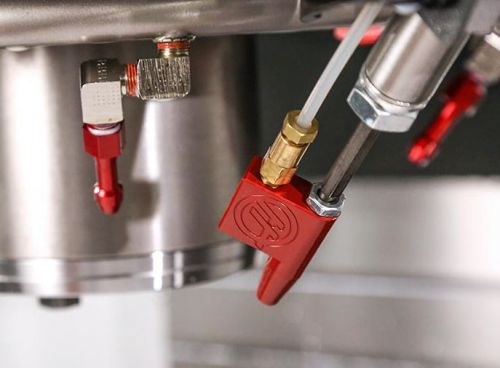Limiting the Lubrication with MQL
A Minimum Quantity Lubrication (MQL) system allows operators to drill holes, tap holes, cut molds and machine metal with little or no coolant.
Share





The Minimum Quantity Lubrication (MQL) system allows machine tool operators to drill holes, tap holes, cut molds and machine metal with little or no coolant by delivering a steady flow of compressed air and small quantity of cutting oil directly to the cutting tool or tap. This reduces heat, removes chips and provides lubrication—not much oil, but just the right amount to be effective. This extends tool life, the company says, and in some cases eliminates the requirement for coolant during milling operations. The system’s key features include:
- An oil reservoir, spray nozzle and pressure-gage regulator
- A needle atomizer valve located at the tip of the Automatic Air Gun (the AAG is required in conjunction with the MQL system)
- The amount of oil delivered is set by the air-pressure regulator on the reservoir
- The air supplied to the reservoir comes from the main air manifold on the machine
- The system does not need a separate air line
- The AAG air line is connected to the MQL reservoir
- Recommended air pressure is between 40/60 psi (2.7/4.1 bar), depending on the type of oil
Haas lists benefits including reduced chip welding, improved part quality, a cleaner machine both inside and out, and chips that are dry and ready to be recycled. In some applications the company says that MQL eliminates the requirement for flood coolant.

Related Content
-
The Impact of Cutting Teeth Spacing on Machining Stability
Many cutter designs are available, and variable teeth spacing (or variable pitch) cutters can be used to influence milling stability. Let’s discuss why teeth spacing affects stability.
-
Inside the Process of Cutting Tool Recycling
Global Tungsten & Powders, part of the Ceratizit Group, sheds light on the processing steps that convert a shop’s used inserts into new tools and other applications.
-
How to Mitigate Chatter to Boost Machining Rates
There are usually better solutions to chatter than just reducing the feed rate. Through vibration analysis, the chatter problem can be solved, enabling much higher metal removal rates, better quality and longer tool life.












